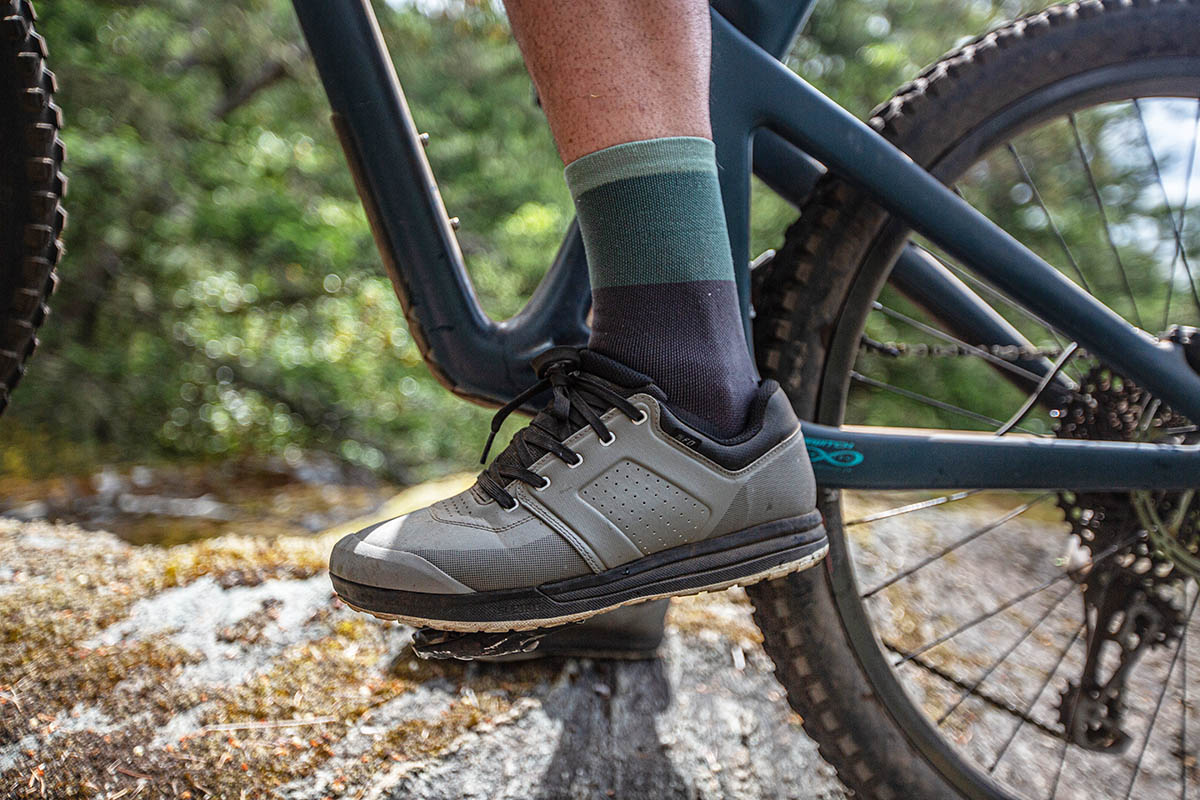
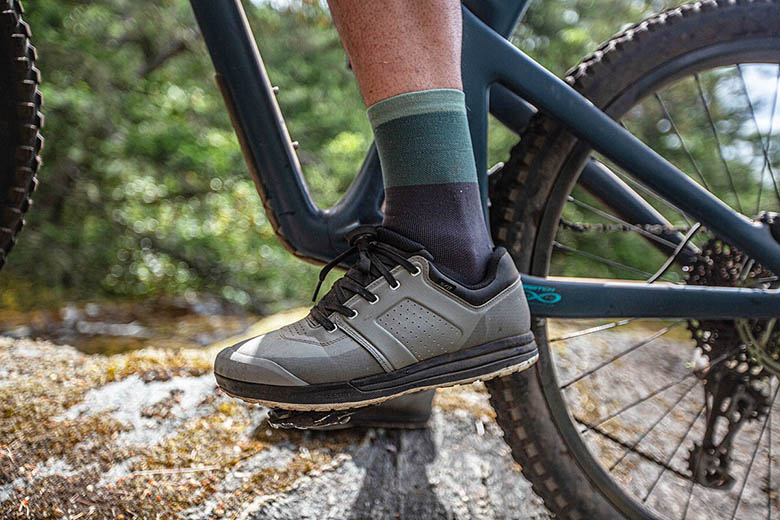
Switchback Travel (Brian McCurdy)
A quality mountain bike shoe plays a number of important roles. Its solid platform delivers power to the pedals, strong construction keeps your feet protected, and secure fit increases comfort for long days on the trail. Our top picks for 2024 below fall into three general categories: lightweight cross-country (XC) designs for extended and non-technical rides, trail shoes that can handle moderately rough terrain, and downhill models for the harshest trails and biggest jumps and drops. Another important consideration is your pedal type, and we’ve included our favorite options for those who prefer flats or like to be clipped in (somewhat confusingly referred to as “clipless”). For more background information, see our comparison table and buying advice below the picks.
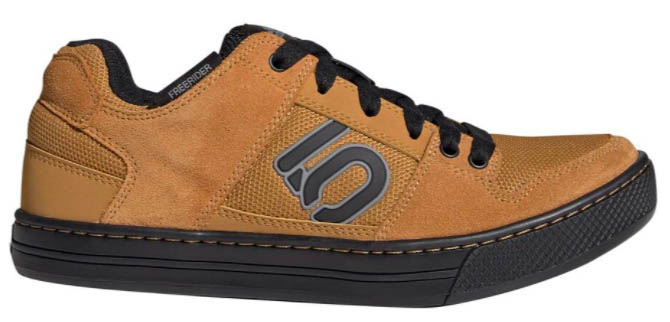 Category: Trail
Category: Trail
Pedal compatibility: Flat
Weight: 1 lb. 11.6 oz.
What we like: Proven design with very sticky rubber.
What we don’t: Not the most durable and less efficient than a clipless shoe.
Combining legendary grip and a comfortable interior, Five Ten’s Freerider is a long-time favorite. The shoe’s main calling card is its sticky Stealth S1 rubber and dotty tread pattern, which provide a reliable and secure connection to your pedals for everything from long uphill grinds to popping off jumps and navigating technical features. In addition, the shoe’s midsole strikes a nice balance of stiffness to avoid hotspots while retaining enough flexibility and traction on rock for the occasional hike-a-bike (the dotty tread doesn’t grip as well in mud, however). Finally, the reinforced toe box and thick upper material offer decent protection and give the shoe its signature look.
Like all platform shoes, one of the downsides of the Five Ten Freerider is that you lose some efficiency and power by not being connected to the pedals. Additionally, the Freerider’s soft rubber has a reputation for breaking down fairly quickly, and high-mileage users will find they need to replace their shoes annually (we consistently need a new pair after about 1,000 trail miles). But the shorter lifespan is a fair tradeoff for the fantastic grip the shoe offers, and there’s simply nothing else on the market that can match the Freerider’s all-around abilities for the price. And for a lighter and more protective variation of the shoe, check out the Freerider Pro below.
See the Men's Five Ten Freerider See the Women's Five Ten Freerider
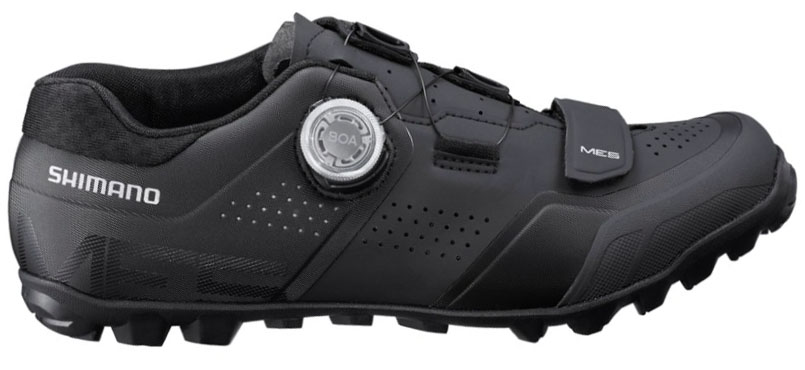 Category: Trail/XC
Category: Trail/XC
Pedal compatibility: Clipless
Weight: 1 lb. 8.8 oz.
What we like: Great combination of comfort, weight, and performance.
What we don’t: Not as protective as the upgraded ME7 model.
Shimano’s ME5 is a do-everything clipless mountain bike shoe. With a light and breathable construction and moderately rigid platform, it can put the power down on punchy climbs, but it’s also protective, lightly padded, and quite comfortable inside. The fit is easy to adjust with a proven Boa system and a single Velcro closure across the toes (after setting it the first time, you can just leave the toe adjustment alone). And Shimano honed in the design with a recent update that improves the on and off process—the opening used to be on the small side and required some precision to get your foot through. On our feet, the ME5 has proven to be our favorite one-quiver clipless shoe for anything from rough trail rides in the Pacific Northwest to all-day epics.
We consider the ME5 to be the best all-rounder on the market, but Shimano’s lineup also includes the popular ME7. This shoe has been designed for enduro racing and downhill tracks with its taller neoprene cuff, sticky Michelin rubber (the ME5’s is an in-house design that’s a bit less grippy on rock), and additional lace guard. You pay a small weight penalty of about an ounce per shoe and the taller cuff can take some getting used to (it felt more restrictive on pedal-heavy days), but the ME7 provides a nice boost in protection and all-weather performance. For certain riders, it’ll be worth the extra $50.
See the Shimano SH-ME5
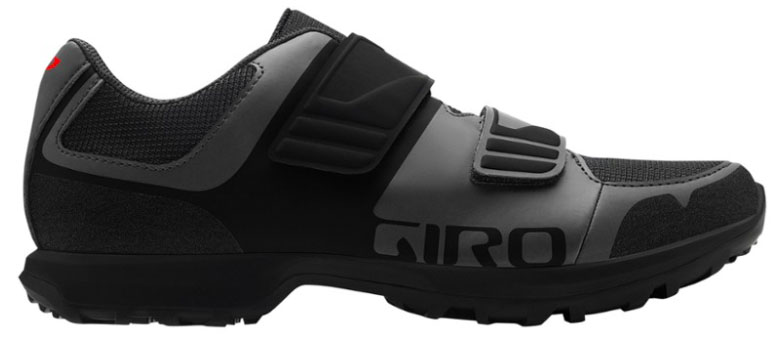 Category: XC/trail
Category: XC/trail
Pedal compatibility: Clipless
Weight: 1 lb. 13.2 oz.
What we like: Fantastic value for a clipless trail shoe.
What we don’t: Noticeable step down in performance compared with pricier options.
It’s hard to find a quality pair of clipless shoes for under $100, but Giro has managed just that with their Berm. For a very reasonable $75, you get a surprisingly good setup for everyday trail riding: a sturdy upper material that mixes breathability with protection, an adjustable fit, and a rubber outsole with substantial lugs for added grip in dirt and mud. Plus, the shoe’s wide cleat pocket makes it easier for those still learning the ropes to clip in. It’s certainly not a high-performance design like the Shimano ME5 above, and committed riders should steer clear, but we think the Berm offers a whole lot of bang for your buck.
At less than half the price of the top-rated Shimano or Giro’s own Ventana below, there are inevitably going to be some compromises in the Berm’s design. First up is power: the midsole priorities comfort over stiffness, so its relatively flexible build isn’t very efficient. Second, the dual Velcro closures lack the precision and easy adjustability of a Boa or ratchet-style system. And finally, while the outsole is aggressively shaped, it isn’t going to grip as well on rock or in particularly steep and rough sections of trail. To be fair, these are all expected sacrifices, and we think the Berm is a truly impressive value option for beginners or those that only get out on the occasional trail day.
See the Men's Giro Berm See the Women's Giro Berm
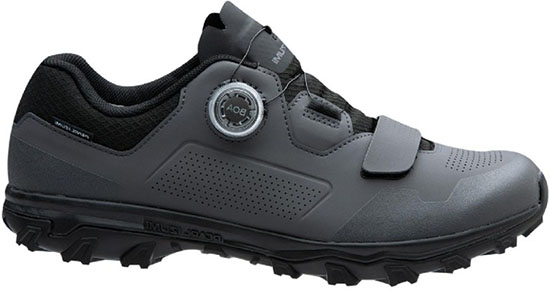 Category: Trail
Category: Trail
Pedal compatibility: Clipless
Weight: 1 lb. 7 oz.
What we like: A solid all-rounder with good off-the-bike comfort.
What we don’t: A little too soft for XC riders.
Another big-time player in the bike shoe market is Colorado-based Pearl Izumi. The company excels in the adventure and bikepacking category, and one of their strongest offerings is the clipless X-Alp Summit. Intended for intermediate riders, trail use, and off-the-bike exploration, it has the right ingredients: a composite shank in the midsole for control, durable upper material, and decent toe protection that wraps partway around the sides of the foot. You also get an aggressive and sticky Vibram outsole—a common choice for trail running and hiking footwear. At $150, the X-Alp Summit is a solid value for a shoe that can handle anything from all-mountain ripping to overnighters with extended hike-a-bikes.
What’s not to like with the mid-range design? Pearl Izumi put a premium on hiking comfort, which translates to less rigidity and outright power when really torquing on the pedals (XC cyclists should steer clear). And riders in flatter regions that don’t see major elevation gains (the Midwest of the United States comes to mind) also won’t be able to tap into the X-Alp’s adventure-ready feature set. But for areas like Pearl Izumi’s home state of Colorado or those that like to hit the backcountry in the Pacific Northwest, there’s a whole lot to like about the X-Alp’s versatile design.
See the Men's Pearl Izumi X-Alp Summit See the Women's Pearl Izumi X-Alp Summit
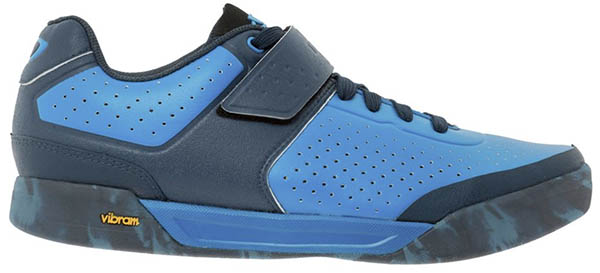 Category: Trail/downhill
Category: Trail/downhill
Pedal compatibility: Clipless
Weight: 2 lb. 3.6 oz.
What we like: Clipless compatibility combined with the look and feel of a flat-pedal shoe.
What we don’t: Heavy design.
Many top gravity riders choose Giro’s Chamber, and the latest II is an even more downhill- and enduro-focused race design. The shoe is perhaps most noteworthy for its casual, flat-pedal-shoe look, but don’t be fooled by appearances. With an almost seamless upper, shank that balances rigidity under the middle of the foot with enough flex for comfortable hiking, and adjustable cleat position, this shoe offers the height of performance. The cleat setback of 10 millimeters is especially intriguing—essentially, it’s the positioning of a flat-pedal shoe combined with the power of a clipless connection, resulting in less foot fatigue and better control on technical terrain.
While the Chamber II has dropped some weight from its previous iteration, there’s no denying that this is not a light shoe. Its robust design, which is made to take on miles of gnarly trail abuse, does little to shave weight. Although the Chamber II is known to pedal quite well, it wouldn’t be our first choice for all-day slogs or XC rides. Also, while laces can be great for getting that perfect fit, we prefer Velcro straps and ratchets for their quick micro adjustments and general ease of use. But with impressive durability and protection, and a stiff sole that offers exceptional power transfer, the Chamber II will be well worth its weight for serious riders.
See the Giro Chamber II
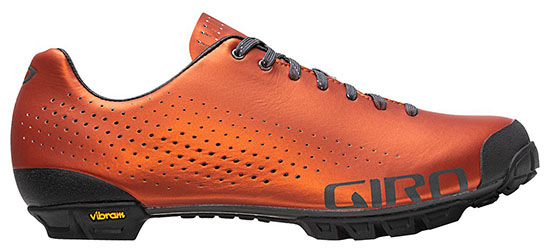 Category: XC
Category: XC
Pedal compatibility: Clipless
Weight: 1 lb. 6 oz.
What we like: Superlight and powerful; looks great.
What we don’t: Pricey and overkill unless you’re a serious XC rider.
Giro’s Empire VR90 shoe is borderline legendary, mixing a clean, road shoe style with comfort and legit trail chops. At $300, you pay a pretty penny, but there’s serious performance built in: a full carbon fiber outsole gives it plenty of stiffness for toeing the race line, the one-piece upper is downright gorgeous and helps keep weight in check, and a Vibram outsole makes it surprisingly capable off the bike. It’s also made to last with premium materials used throughout and enough reinforcements to justify bringing it into moderately technical terrain (although serious trail riders will still want a beefier construction).
One compromise of the Giro’s performance-first layout is its snug fit, which is great for power-hungry riders but will feel restrictive on long, adventure-y days and less serious exploits. And the standard lacing system means you trade the quick adjustability of a Boa dial for better overall customization of the fit. But realistically, the biggest downside of the Giro is its price—if you spring for this shoe, it means you’re likely shaving grams from your rig wherever possible and are hoping to eke out all the watts you’re putting down with each pedal stroke. If you don’t fall under this category of rider, the Empire is likely not the best choice for you.
See the Giro Empire VR90 See the Women's Giro Empire VR90
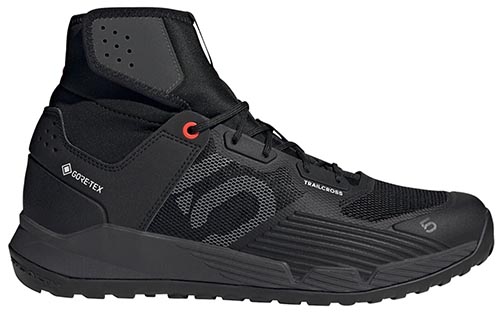 Category: Trail
Category: Trail
Pedal compatibility: Flat
Weight: 1 lb. 13.3 oz.
What we like: Excellent waterproofing and protection for the cold and wet.
What we don’t: Pricey for a shoe you won’t use most of the year.
A lot of cyclists turn to indoor training for the winter months, but for those who don’t mind a little cold and wet misery, we recommend checking out Five Ten’s Trailcross GTX shoes. This flat-pedal design features a Gore-Tex liner and raised neoprene cuff to help keep out moisture. The combo works as advertised: We remained completely dry while hike-a-biking in sub-freezing temperatures through ankle deep snow, and the Gore-Tex bootie also provided a good dose of warmth for the downhill. Rounding out the design, the brand’s signature dotty tread and Stealth rubber compound provide reliable grip both on and off the bike.
What are the shortcomings of Five Ten’s Trailcross GTX? The full waterproof layer means the shoes run hot in mild temperatures, especially when pushing hard on an extended climb. This means you’re shelling out $200 for a product you’ll likely only use for a few months a year. That said, it easily undercuts the cost of an indoor bike trainer, so the math checks out (at least to us). For some, the over-the-ankle look may be a bit polarizing, but we think Five Ten pulled it off better than most with a sleek, modern hiking shoe-like upper. And a final note: For winter riders who run clipless pedals, Shimano’s SH-MW702 ($300) is currently our top-rated choice.
See the Five Ten Trailcross GTX
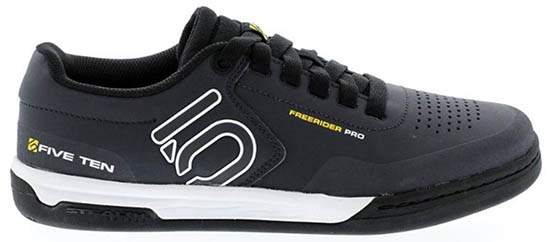 Category: Trail/downhill
Category: Trail/downhill
Pedal compatibility: Flat
Weight: 1 lb. 7.8 oz.
What we like: Lighter, stiffer, and sleeker-looking than the Freerider above.
What we don’t: Its outsole still wears out as quickly as the $50-cheaper standard model.
As the name indicates, Five Ten’s Freerider Pro is an upgraded variation of the popular Freerider shoe. For another $50, you get a lighter and more water-resistant synthetic upper, stiffer midsole for better shock absorption, and sleeker look that forgoes the standard model’s skate shoe-like styling. In addition, the toe box has been reinforced and includes some foam padding to provide an additional layer of protection from impacts (although we’ve found the standard Freerider’s toe box to be pretty tough). Importantly, you still get Five Ten’s class leading Stealth S1 rubber, which is simply unmatched in terms of grip and reliable hold to your pedals.
Who should opt for the Pro model over the cheaper Freerider? If your local terrain is particularly tough or you get out in wet conditions, the synthetic upper material is a nice upgrade over the heavier and more absorbent leather/mesh combination that comes on the standard model. On the other hand, you’re not getting significant improvements in on- and off-bike traction or fit with the simple lacing systems, and both models will have fairly short lifespans due to the soft rubber compound. In the end, the Pro has its merits for committed cyclists and those that will value the weight savings, but many trail riders will be better off with the standard model.
See the Men's Five Ten Freerider Pro See the Women's Freerider Pro
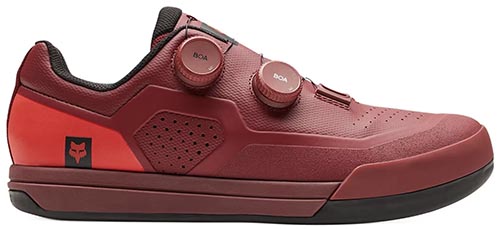 Category: Trail/downhill
Category: Trail/downhill
Pedal compatibility: Clipless
Weight: 1 lb. 15.2 oz.
What we like: Impressive first effort for Fox; great mix of comfort, protection, and power.
What we don’t: Pricey, relatively heavy, and stiff collar took some time to break in.
Best known for their top-notch suspension forks and shocks, Fox has been dabbling more and more in the MTB apparel and accessory world. The Union is their first effort at clipless shoes—we tested the high-end Boa version—and we felt they knocked it out of the park: The shoe’s supportive platform delivers plenty of power for lengthy trail rides, the durable and protective TPU upper is confidence-inspiring on techy descents, and we love how easy it is to dial in and micro-adjust the fit with the dual Boas. Tack on a true-to-size fit (it’s great for average to slightly wide feet), very clean styling, and premium, long-lasting materials throughout, and you have all the ingredients for a quality trail and enduro shoe.
The biggest impediment with the new Fox Union Boa is its price. Even stepping down to the standard laces variation leaves you with a $180 investment—plus, we think the Boa system’s precision and ease of use is well worth the upgrade. Additionally, the shoe is on the heavy end at about 2 pounds for the pair (our size 45s were 2 lb. 3.8 oz.), but the extra heft wasn’t something we really noticed on the bike (it’d be a different story on a long hike-a-bike). And one final nitpick is that we found the collar was pretty stiff initially and uncomfortable if we cinched the upper Boa too tightly, but that issue went away as the shoe loosened up over time. In the end, we’re talking about a really well-executed first effort. And it’s readily apparent Fox sweated the details here, with tacky outsoles, a wide cleat pocket with plenty of fore and aft adjustability, and the option to swap between low and high arch support.
See the Fox Union Boa
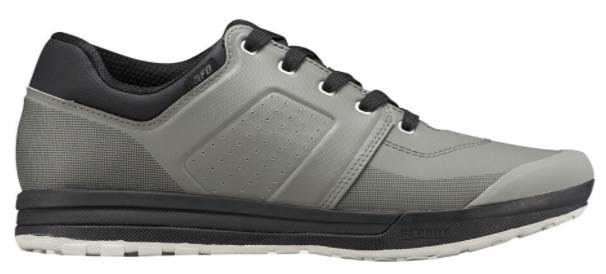 Category: Trail/downhill
Category: Trail/downhill
Pedal compatibility: Clipless
Weight: 1 lb. 11.9 oz.
What we like: Powerful, sturdy, reasonably light, and great traction.
What we don’t: We think it would benefit from a Boa closure.
Sitting in the mid-range of Specialized's 2FO collection is the DH Clip shoe. Right off the bat, we want to address the “DH” in the name: despite the beefed-up design that’s tough and downhill-ready, we think that’s selling these shoes a bit short. With a composite nylon plate underfoot, a reasonable weight of 1 pound 11.9 ounces, and trimmed-down build that dries fairly quickly, the shoes are plenty capable on mellower terrain and long trail rides. And for the enduro and downhill enthusiasts among us, Specialized has done a great job incorporating extra protection around the toes and heel cap, and the slightly raised padding along the inside of the ankle is another nice touch.
While the 2FO DH in many ways stacks up well with the brand's top-end 2FO Cliplite (while costing $30 less), we do miss that model's dual Boa closures. The laces on the DH are perfectly fine and can be tucked away under an elastic band to keep them from flopping around, but they can’t match the micro adjustability and all-around convenience of the Boa system. In addition, we found the shoe a little flat and board-like underfoot, which led to some aching arches on pedal-heavy days (we suspect this won’t be an issue for everyone, though). Finally, if you prefer to ride flats, the 2FO DH Flat ($160) is one of only a few models on the market to legitimately give Five Ten a run for its money in pedal grip thanks to its tacky SlipKnot 2.0 rubber... Read in-depth review
See the Specialized 2FO DH Clip
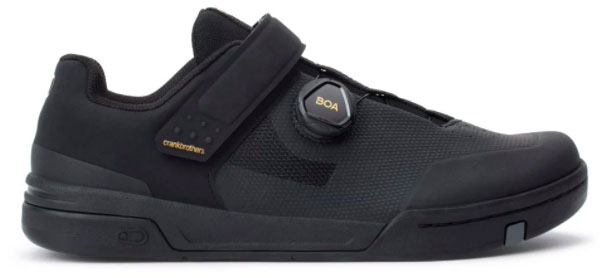 Category: Trail/downhill
Category: Trail/downhill
Pedal compatibility: Flat
Weight: 1 lb. 11 oz.
What we like: Appealing combination of a Boa closure on a tough flat-pedal shoe.
What we don’t: Not a leader in pedal grip; boring styling.
Crankbrothers is best known for their flat and clipless pedal collections, but they recently threw their hat into the shoe world. The naming scheme is easy to follow if you’re familiar with the brand’s pedal line: The Mallet is a clipless shoe that’s designed to work with the corresponding clipless pedal, and the same goes for the flat-pedal Stamp. Interestingly, they’ve decided to make a range of closure systems, including standard laces, a quick-pull design, and Boa (price increases with each setup). The top-of-the-line Stamp Boa model jumped out as the most interesting of the bunch, offering a unique combination of a sturdy and semi-stiff enduro-ready flat pedal shoe with the easy, precise fit adjustment of the twist-dial tech.
Pedal grip is a huge consideration for those who ride flats, and Crankbrothers have optimized the outsole to pair with the Stamp pedal (although it will work with others reasonably well too). Unfortunately, their proprietary rubber can’t match the stickiness that you get with Five Ten’s Freerider Pro above (or the SlipKnot rubber on Specialized shoes). In addition, while looks are pretty subjective, we can’t help but feel like Crankbrothers missed an opportunity to make the new shoe stand out with less generic styling. That said, if you own a pair of Stamp pedals or are on the lookout for a pair of Boa-equipped flat shoes, we think they’re well worth checking out.
See the Crankbrothers Stamp Boa
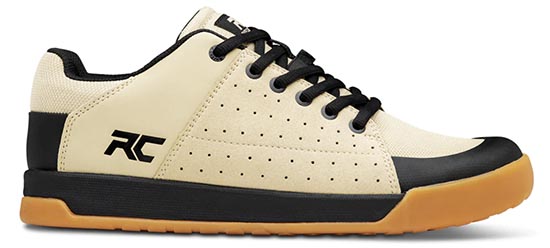 Category: Trail/downhill
Category: Trail/downhill
Pedal compatibility: Flat
Weight: 1 lb. 14.6 oz.
What we like: Solid alternative to popular models from Five Ten and Shimano.
What we don’t: Heavy for trail riding.
Ride Concepts is a relative newcomer to the mountain bike shoe world, but the company already is making a serious name for themselves. The Livewire is their entry-level trail offering, and we like its tough rubber outsole, modern looks, and approachable $110 MSRP. Further, the shoe includes higher-end touches like a synthetic upper and impact protection at the heel and underfoot. And with a moderately thick midsole and recently upgraded rubber—their new Max Grip compound is a bit softer and stickier than the outgoing model—you have a shoe that crosses over nicely between flowy trail days and bike park laps.
The biggest downside to the Livewire is its weight, which is stretching into the downhill world at nearly 2 pounds for the pair. It’s still manageable and not overly clunky for pedal-heavy days, but we prefer the lighter and nimbler feel of the Freerider and Freerider Pro above. Further, the low-volume fit isn’t great for wide feet, and some users have reported needing to size up. These issues move the Livewire a little down our rankings, but we think Ride Concepts is definitely a brand to have on your radar going forward. Another Ride Concepts shoe to have on your radar is their Tallac ($160), which includes upgrades like a Cordura upper, more aggressive lug shape for off-the-bike grip, and a better shock-absorbing insole.
See the Men's Ride Concepts Livewire See the Women's Ride Concepts Livewire
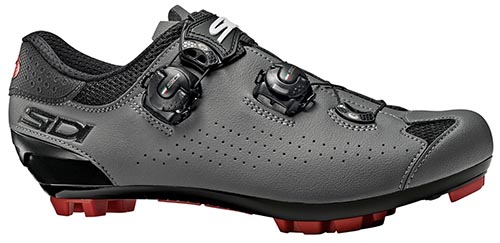 Category: XC
Category: XC
Pedal compatibility: Clipless
Weight: 1 lb. 10.6 oz.
What we like: Comfortable fit and excellent build quality.
What we don’t: Still not a great walking/hiking shoe.
Sidi is well-known in the biking world for two things: high prices and premium build quality. Their most popular mountain biking model, the Dominator, is case in point. At $325, it’s one of the most expensive options around but delivers on comfort and performance in a serious way. With a stiff outsole, low-volume fit (Sidi also makes the Dominator 10 in a wide “mega” version), and sturdy upper, the shoe nearly puts down XC race levels of power. And its high-end construction and replaceable parts make the Dominator a good long-term investment to boot.
What do you sacrifice with a XC shoe like the Dominator? Despite softening the rubber compound a few years ago, this is not an impressive walking or hiking option. It’s tolerable for gravel rides and cyclocross events where you’re moving for short stretches and the strong power is a worthwhile tradeoff, but those that are off their bike for longer periods may want to choose a more flexible and grippier trail model. It’s also fairly thin underfoot and doesn’t isolate harsh impacts as well as shoes like the ME5, 2FO DH Clip, or Ventana. But the Dominator is an excellent choice for XC riders that spend a lot of time in the saddle.
See the Men's Sidi Dominator 10
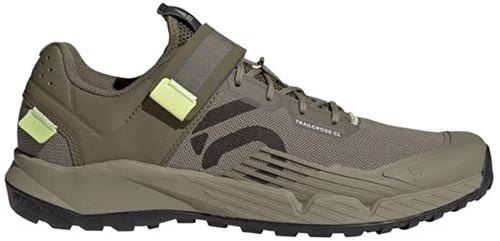 Category: Trail
Category: Trail
Pedal compatibility: Clipless
Weight: 1 lb. 14.2 oz.
What we like: Sneaker-like feel with excellent off-the-bike comfort.
What we don’t: Too flexible to be a performance shoe; not protective enough for technical terrain.
Five Ten’s MTB shoe line covers nearly the full spectrum of options, and the popular Trailcross here slots in as a unique, adventure-ready shoe. From the moment you slip it on, the difference is clear: The Trailcross has a sneaker-like upper that ventilates very well, there’s enough flex underfoot for extended stretches of hiking or walking, and the outsole grips reliably on everything from rock to dirt. This comfort-first design makes the shoe an equally suitable option for bikepacking and adventurous days above treeline as it is for casual mountain bikers that want a crossover urban design.
With so much focus on off-the-bike performance, it should come as little surprise that the Trailcross is not a particularly powerful shoe. There’s sufficient stiffness to limit fatigue and it’s perfectly comfortable pedaling away on rolling terrain, but you don’t get the instant response of an XC model. They also took a minimalist approach to protection, with a toe cap at the front and some cushioning along the collar but little elsewhere. And on rocky and technical trails, the thin fabric along the sides and top of the shoe left us feeling pretty vulnerable. As such, serious riders in both the XC and trail disciplines should look elsewhere. But if you put comfort at or near the top of your list of priorities, the Trailcross is well worth a look.
See the Men's Five Ten Trailcross See the Women's Five Ten Trailcross
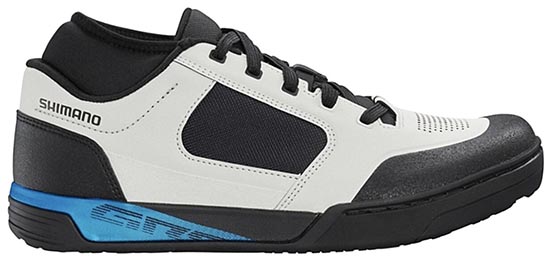 Category: Trail/downhill
Category: Trail/downhill
Pedal compatibility: Flat
Weight: 1 lb. 11.6 oz.
What we like: Comfortable with good protection.
What we don’t: Grip falls short of the Five Ten options on this list.
Shimano is a major player in the clipless world—understandably as they make the ubiquitous SPD clipless pedals—but they also have a sneaky-good flat pedal lineup. Their $170 GR9 (GR stands for “gravity”) is a solid offering meant to balance the needs of trail and downhill riders. It features a similar neoprene cuff as the ME7 for keeping out small rocks and dirt, but this top-end model has standard laces (a slight downside in our eyes, especially since they lack a protective cover). That said, we’ve tested a number of the GR models over the years and have been consistently impressed with the collection’s comfortable feel and high-quality, long-lasting build.
For the GR9’s all-important outsole, Shimano has debuted its latest Ultread compound and a new tread design. The result is a durable rubber setup with tightly spaced blocks in the middle for pedal grip and wider spacing at the toe and heel for off-the-bike traction. Overall, the outsole has a firm feel that’s built to last, but it simply can’t match Five Ten’s Stealth rubber in terms of pure stickiness. As such, unless its neoprene cuff is a selling point for you, we think Five Ten’s $10-cheaper Freerider Pro above is the superior premium option.
See the Shimano GR903
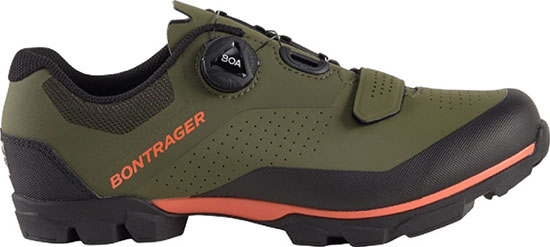 Category: XC/trail
Category: XC/trail
Pedal compatibility: Clipless
Weight: 1 lb. 10 oz.
What we like: Good all-around performance for various cycling disciplines.
What we don’t: It also doesn't excel in any specific category.
Bontrager has been tweaking its versatile Foray shoe over the past few years, and we like where they’ve landed with this latest model. Intended for riders that like to mix in a range of disciplines, swapping from their trail bike to cyclocross or gravel grinder, the shoe hits a nice balance of comfort and performance. A moderately roomy fit and easy-to-adjust Boa dial make it a suitable choice for flow trails and short laps, but it can still put the power down pretty well with a nylon composite sole (Bontrager gives it a 6 out of 14 rating for stiffness). Traction on dirt is another highlight, and the integrated nylon cleats under the toes do an especially good job gripping on steep slopes.
Despite its well-rounded nature, the Foray unfortunately doesn’t truly stand out in any specific category. It’s a bit heavy and doesn’t launch you forward like a cross-country-oriented or gravel-specific shoe, and its shock absorption and protection fall short for rough trail riding. Further, the traditional outsole shape and tread pattern come up short on rock, where they’re lacking grip and are harder to trust. Within the unofficial “do-everything” category, we think the Shimano ME5 and Pearl Izumi X-Alp Summit are better options, but the Foray does have the widest fit of the bunch for those that need a little extra wiggle room.
See the Bontrager Foray
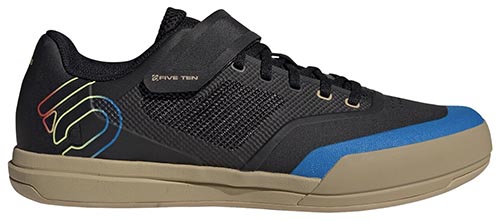 Category: Downhill
Category: Downhill
Pedal compatibility: Clipless
Weight: 2 lb. 6 oz.
What we like: Burly clipless design.
What we don’t: Overkill and heavy for a lot of riders.
The fourth Five Ten shoe to make our list, the Hellcat Pro, blends a downhill-minded construction with clipless pedal compatibility. Compared with the Freerider Pro above, the Hellcat puts down the power better with a midsole that’s been stiffened up with a TPU shank. The shoe also has been reinforced for downhill use with heavy armor along the exterior and thick cushioning underfoot to block out harsh impacts. And as we’ve come to expect from Five Ten, the Hellcat has a sticky tread that holds on nicely to the pedals even when not clipped in.
What pushes the Hellcat Pro down our list is that it’s overkill for most riders. Weighing well over 2 pounds, it’s 10 ounces heavier than alternatives like the Specialized 2FO DH Clip above. You do get more foot protection and the shoe performs well in bad weather, but the DH Clip is much easier to pedal and is plenty beefed up for most enduro use (plus, the Hellcat costs $30 more than Giro's similarly tough Chamber II). If you want your feet heavily armored, no matter the cost in pedaling efficiency, the Hellcat Pro is a fine choice. But most riders will be happier with the aforementioned Chamber or DH Clip.
See the Men's Five Ten Hellcat Pro See the Women's Five Ten Hellcat Pro
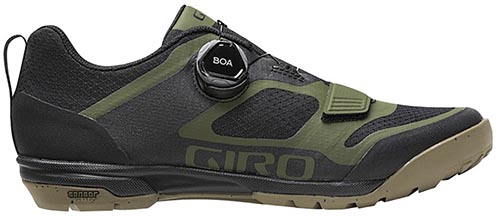 Category: Trail/XC
Category: Trail/XC
Pedal compatibility: Clipless
Weight: 1 lb. 13.4 oz.
What we like: Sturdy, powerful, and good looking.
What we don’t: Awkwardly small cleat pocket.
Taking the place of the much-loved Terraduro as Giro’s core trail offering is the Ventana. This design shares the sturdy feel of the discontinued model but has been thoroughly modernized with a sleek and minimalist upper, high-quality Boa closure, and grippier outsole. A unique touch is the placement of the cleat pocket, which is set further inboard than most designs on the market. The goal is to improve stability and control, although that’s been hard to quantify while testing (the good news is it doesn’t negatively impact comfort). Along with its moderately stiff construction that balances walkability with power nicely, the Ventana makes a strong case for riders that rack up serious mileage.
In using the Ventana back-to-back with our top-rated ME5 above, a few things stuck out. Most notably, the Ventana is the stiffer build, which was nice on longer days and for extended climbs. But where the tables turn is in some of the finer details. The cleat pocket of the Ventana has been a source of consistent annoyance: it’s unnecessarily compact and makes clipping in a real pain. In addition, the Giro’s Boa dial has a plastic piece along the bottom for protection, but its placement unfortunately makes it harder to adjust on the trail (cancelling out one of the main benefits of a Boa cinch). In the end, we think plenty of riders will enjoy the Ventana, but it’s a few design tweaks away from being a top pick.
See the Men's Giro Ventana See the Women's Giro Ventana
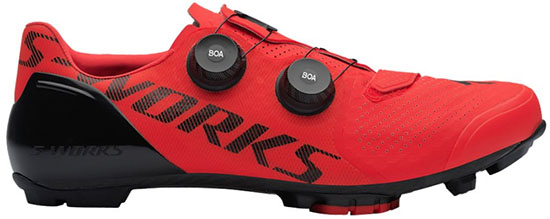 Category: XC
Category: XC
Pedal compatibility: Clipless
Weight: 1 lb. 3 oz.
What we like: Powerful and ultralight.
What we don’t: Lots of compromises for non-racers.
Specialized’s S-Works Recon is designed for cross-country, cyclocross, and gravel racers that want an uncompromisingly powerful and ultralight shoe. At $425, it’s eye-wateringly expensive, but the use of premium materials and construction provide incredible on-bike performance. The fit is very snug to maximize efficiency with a rigid Dyneema mesh upper and dual Boa dials across the top of the foot. Built on Specialized’s stiffest mountain bike sole—stiff enough to make walking somewhat uncomfortable and awkward—power is transferred instantaneously and effortlessly to the pedals. And at 1 pound 3 ounces, the S-Works Recon is the lightest shoe on this list by 3.2 ounces, shedding precious rotational weight to trim every last second off of a timed segment.
If you aren’t a serious rider or dedicated racer, however, you’ll find plenty to complain about. The S-Works Recon essentially is a lightly protected road design, so there is minimal cushioning and reinforcement around the toes and ankle. Further, the snug fit that connects you so well to the pedals compromises long-term comfort and is difficult to wear while walking. Realistically, the S-Works Recon has very limited appeal, but that doesn’t make it any less special. For a slightly detuned alternative that’s a bit softer and heavier but still plenty powerful for race day, check out the Giro Empire VR90 above.
See the Specialized S-Works Recon
| Shoe | Price | Category | Pedal | Weight | Closure |
|---|---|---|---|---|---|
| Five Ten Freerider | $110 | Trail | Flat | 1 lb. 11.6 oz. | Laces |
| Shimano SH-ME5 | $170 | Trail/XC | Clipless | 1 lb. 8.8 oz. | Boa, Velcro |
| Giro Berm | $75 | XC/trail | Clipless | 1 lb. 13.2 oz. | Velcro |
| Pearl Izumi X-Alp Summit | $150 | Trail | Clipless | 1 lb. 6 oz. | Boa, Velcro |
| Giro Chamber II | $150 | Trail/downhill | Clipless | 2 lb. 3.6 oz. | Laces, Velcro |
| Giro Empire VR90 | $300 | XC | Clipless | 1 lb. 6 oz. | Laces |
| Five Ten Trailcross GTX | $220 | Trail | Flat | 1 lb. 13.3 oz. | Laces |
| Five Ten Freerider Pro | $160 | Trail/downhill | Flat | 1 lb. 7.8 oz. | Laces |
| Fox Union Boa | $250 | Trai/downhill | Clipless | 1 lb. 15.2 oz. | Boa |
| Specialized 2FO DH Clip | $170 | Trail/downhill | Clipless | 1 lb. 11.9 oz. | Laces |
| Crankbrothers Stamp Boa | $180 | Trail/downhill | Flat | 1 lb. 11 oz. | Boa, Velcro |
| Ride Concepts Livewire | $110 | Trail/downhill | Flat | 1 lb. 14.6 oz. | Laces |
| Sidi Dominator 10 | $325 | XC | Clipless | 1 lb. 10.6 oz. | Dials |
| Five Ten Trailcross Clip-In | $160 | Trail | Clipless | 1 lb. 14.2 oz. | Laces |
| Shimano GR903 | $170 | Trail/downhill | Flat | 1 lb. 11.6 oz. | Laces |
| Bontrager Foray | $165 | XC/trail | Clipless | 1 lb. 10 oz. | Boa, Velcro |
| Five Ten Hellcat Pro | $180 | Downhill | Clipless | 2 lb. 6 oz. | Laces, Velcro |
| Giro Ventana | $180 | Trail/XC | Clipless | 1 lb. 13.4 oz. | Boa, Velcro |
| Specialized S-Works Recon | $425 | XC | Clipless | 1 lb. 3 oz. | Boa, Velcro |
Cross-Country (XC)
Shoes intended for cross-country riding put a high priority on covering ground as easily as possible. These designs often are lightweight, stiff underfoot, and offer a snug fit for maximizing connection to the pedal. Additionally, they almost exclusively are made with a clipless design (which confusingly means you connect or “clip” into the pedal). Compromises include less foot protection than the trail and downhill categories, and the stiff constructions aren’t very comfortable for walking. But for piling on miles as efficiently as possible, a XC shoe is a great choice. Leading models in this category include the Sidi Dominator, Giro Empire VR90, and Specialized’s race-ready S-Works Recon.
.jpg)
Trail
For a versatile shoe that’s comfortable on climbs but offers good protection for descents, choose a trail-ready model. Options in this popular category are more flexible and have better traction than a XC build, but still are reasonably stiff for good pedal power. In addition, you get more protection all around the foot compared with a XC shoe, including marginally better shock absorption underfoot. Design-wise, you have your choice between clipless and flat (also known as platform) pedals. Far and away, the most popular flat pedal all-mountain choice is Five Ten’s Freerider line, while top clipless options include the Shimano SH-ME5 and Pearl Izumi X-Alp Summit.
Downhill
The final category is the most demanding: downhill. From tackling the Whistler bike park to rocky, rooty, and steep descents, these shoes are burly and well cushioned. You’ll see extra layers of protection around the toebox and collar, thick mid and outsole designs to absorb hard hits, and some even offer an over-the-ankle height for maximum defense. Because of the high degree of difficulty and need to occasionally bail off the bike, this is a category where flat shoes are more common than clipless (Five Ten’s clipless Hellcat Pro and Giro's Chamber II are notable exceptions). The downside is weight—these are the heaviest options on average by a good margin and much less efficient for pedaling.
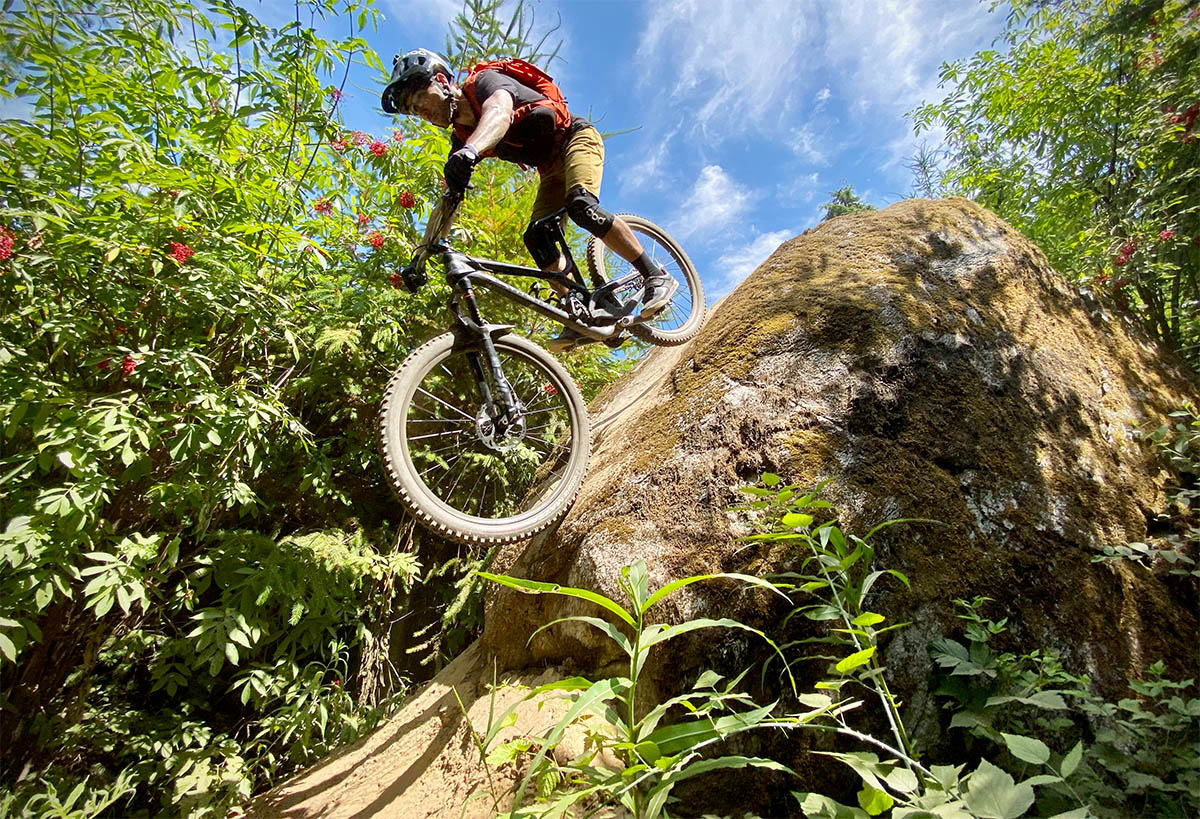
Clipless Shoes
One of the first steps in narrowing down your mountain bike shoe search is determining pedal compatibility. Starting with clipless designs, these shoes allow you to connect or “clip” directly into the pedal with a metal cleat (sold separately). The big upside of being connected is it’s easier to put the power down and pedal efficiently. This makes clipless a popular choice for longer rides and XC use. It also can be comforting to not have to worry about foot slippage while hitting jumps or riding through semi-technical terrain. That said, it takes some time to get comfortable with being clipped in and build up the muscle memory to kick the heel out to disconnect. And even once it’s second nature, you still won’t be able to get your foot off the pedal as quickly as with a flat pedal option. As such, clipless shoes aren’t as popular among beginner riders—unless they’re coming from a road riding background—and fewer folks use them at the bike park or on very rough downhill trails.
.jpg)
Flat-Bottomed Shoes (“Flats”)
As the name indicates, flat shoes have a smooth bottom and work with standard platform pedals. What makes them popular for anyone from beginners to expert freeriders is that they offer a quick escape if you’re stretching your abilities and need to bail. Plus, the use of very sticky rubber like Five Ten’s Stealth S1 means you don’t give up much in terms of connectedness to the pedals. Even with the best outsoles though, flats aren’t as efficient and don’t put down as much power as a performance clipless design. They’re also less forgiving if you use poor technique—although slipping off and hitting your shins a few times will expedite the learning process. Finally, there are fewer flat pedal options—Five Ten dominates this category—and many of the best flats are missing handy features that you’ll find on most clipless shoes, like a ratchet system to get a snug fit.
.jpg)
The good news with choosing a new pair of shoes is that they’ll most likely work with your existing pedals, as long as you’re not switching between clipless and flats. Clipless pedals come in a range of designs from Shimano’s popular SPD collection to Crankbrothers' minimalist Eggbeaters. But all common mountain bike clipless pedals share a two-bolt cleat design (the cleats are typically included in the pedal purchase), which will work with all of the clipless shoes listed above. Similarly, there are no compatibility concerns with flat pedals and flat-bottomed shoes. Finally, if you’re thinking about swapping between flats and clipless or vice versa, it’s very easy to replace pedals yourself—just make sure to loosen them in the right direction.
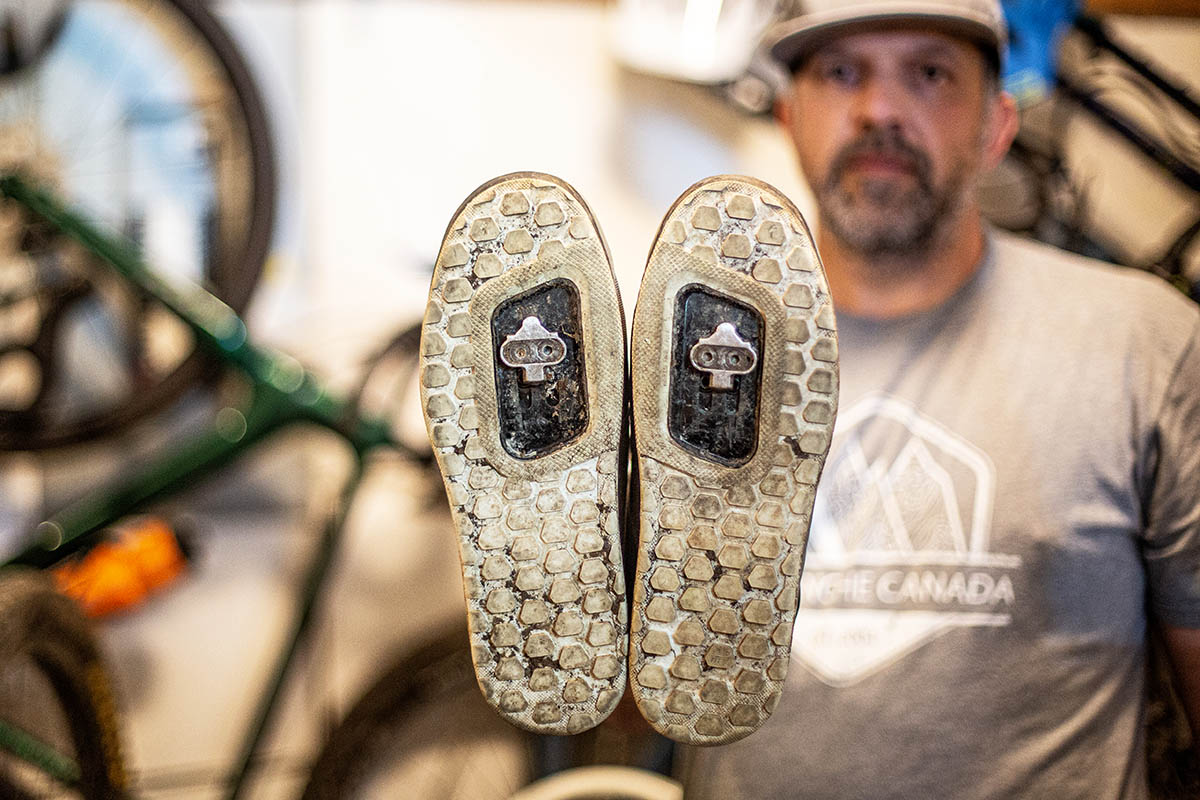
A stiff build underfoot is a defining feature of mountain bike shoes—it’s what allows you to put the power down to the pedals. But the level of stiffness varies quite a bit by model. For example, a dedicated cross-country racing shoe like the Specialized S-Works Recon is incredibly rigid and awkward to walk in, while a budget-friendly trail model like the Five Ten Sleuth is flexible enough to wear every day. Unfortunately there isn’t an established measurement for comparing stiffness (some brands provide a “stiffness index” to compare their models), but in general, rigidity increases with price and level of seriousness. Racers, particularly those in events that require a decent amount of pedaling, will want the stiffest shoes around. For the rest of us, a well-balanced design like the Shimano SH-ME5 or Five Ten Freerider is a better match.
.jpg)
Taking a closer look at construction, manufacturers incorporate stiffness in a few ways. A standard option for a moderately rigid shoe like the Pearl Izumi X-Alp Summit is to insert a ¾-length shank into the midsole. This provides decent strength for pedaling and makes it more comfortable to stand for extended periods, while retaining enough flexibility to walk around. Race-ready designs incorporate strong materials like carbon fiber into the entire length of the sole. This maximizes stiffness for putting power down but compromises in walkability and comfort. The most flexible designs are the cheapest and rely simply on a thick midsole and rubber outsole for shock absorption and rigidity.
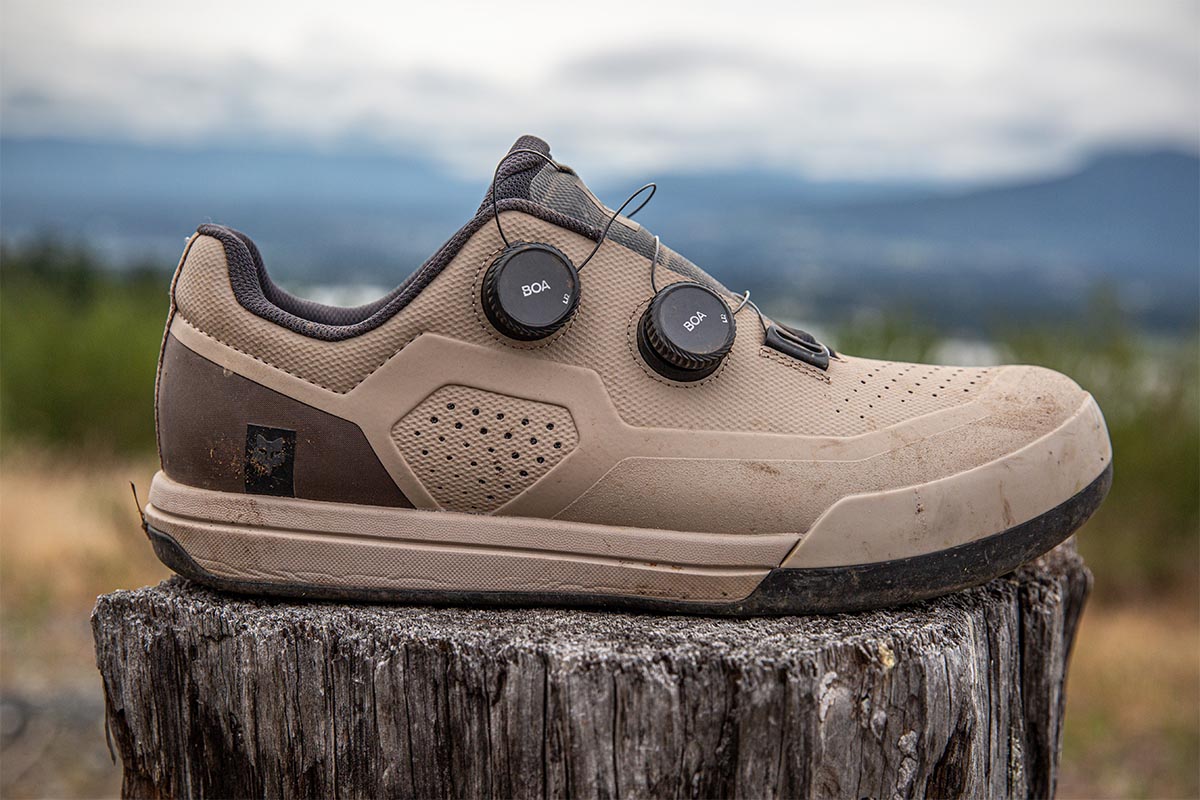
For flat pedal shoes, outsole grip is an extremely important feature—it’s what keeps you connected to the bike while hustling up and down the hill. And for years, Five Ten’s rubber has stood out from the pack. The Stealth S1 compound and dotty pattern on the Freerider line—found on both the standard and Pro models on our list above—is legendary in the mountain biking world. Specialized is one of the few that's made a legitimate competitor with their latest SlipNot compound (found on their 2FO DH Flat). Giro and Shimano incorporate rubber specialists Vibram and Michelin respectively, and their top models offer performance that is good but not great.
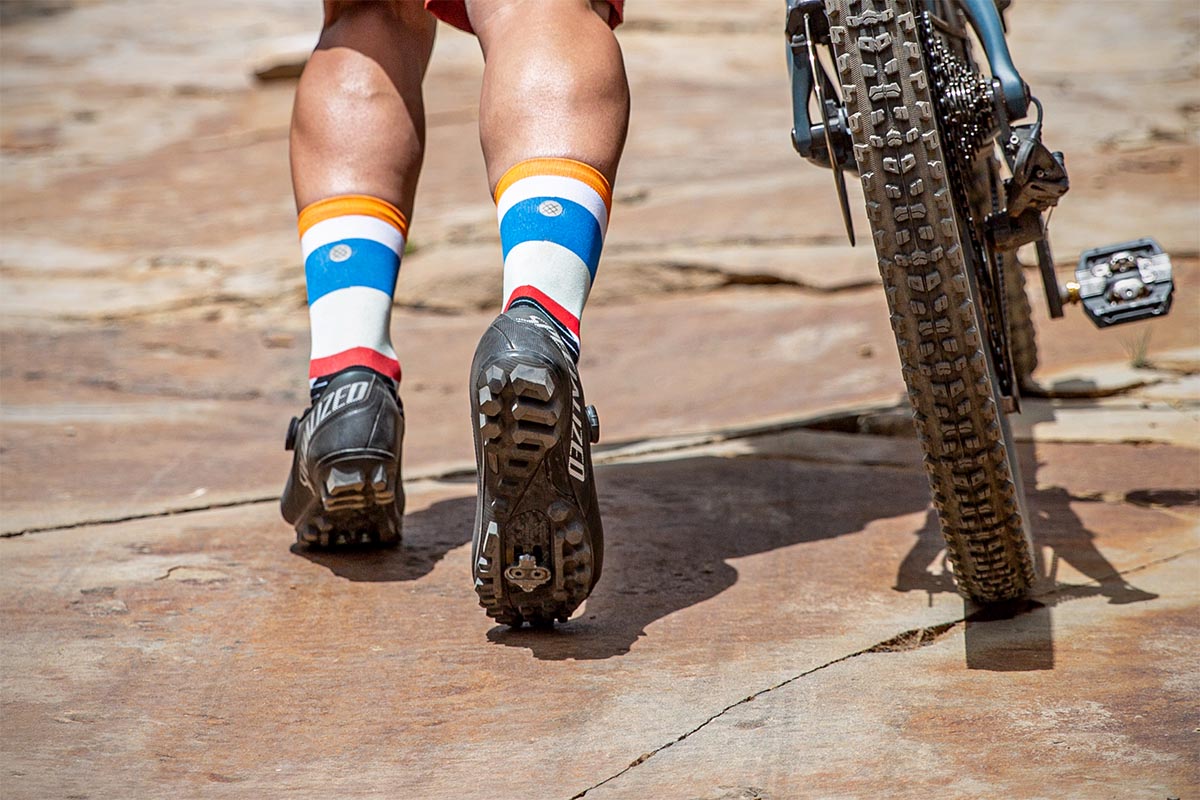
Clipless riders don’t need to focus as much on the outsole design as those riding on flats, but it’s still an important consideration. On the bike, a quality outsole increases your connectedness to the pedal, and can be valuable for moments when you’re temporarily unclipped or trying to quickly reconnect while riding. And off the bike, traction can be a major factor. A well-designed clipless outsole maximizes grip with a recessed slot for the cleat, which allows you to walk naturally. Further, a sticky outsole is a big helper for walking on rocks, and decent lugs—not all that dissimilar from a hiking shoe—are important for sloppy trails. How often you’ll be off your bike will dictate how important grip is for you, but we’ve found premium outsole designs to be valuable even on short (but steep) scrambles.
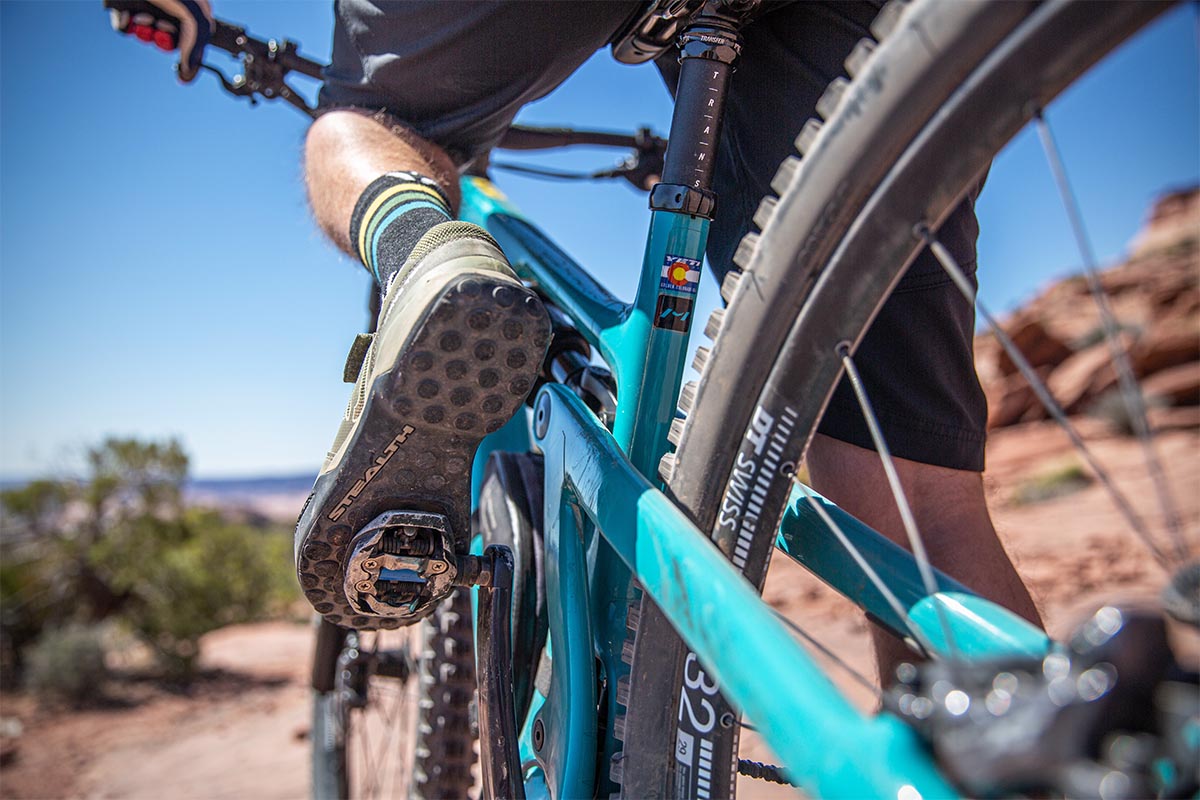
More than just about any other footwear category, mountain bike shoes are made with a wide range of closure types. Our picks above vary from simple lace-up designs like the Five Ten Freerider to double Boa closures and a Velcro strap on the Specialized S-Works Recon. As with pedal type, most of the decision comes down to personal preference, but laces are mostly commonly associated with flat pedal shoes. Laces are simple to use, but you need to make sure to keep them stowed away so they don’t catch on any moving parts. For quick and easy micro adjustments while wearing gloves, a Boa dial system or ratchet design is a great option. These lightweight systems are common on clipless XC and Enduro models. And finally, Velcro often is used as a secondary closure to compliment a dial and ratchet system. It doesn’t tighten as snugly or precisely, but it’s faster than lacing up and does the trick for those that aren’t serious racers.
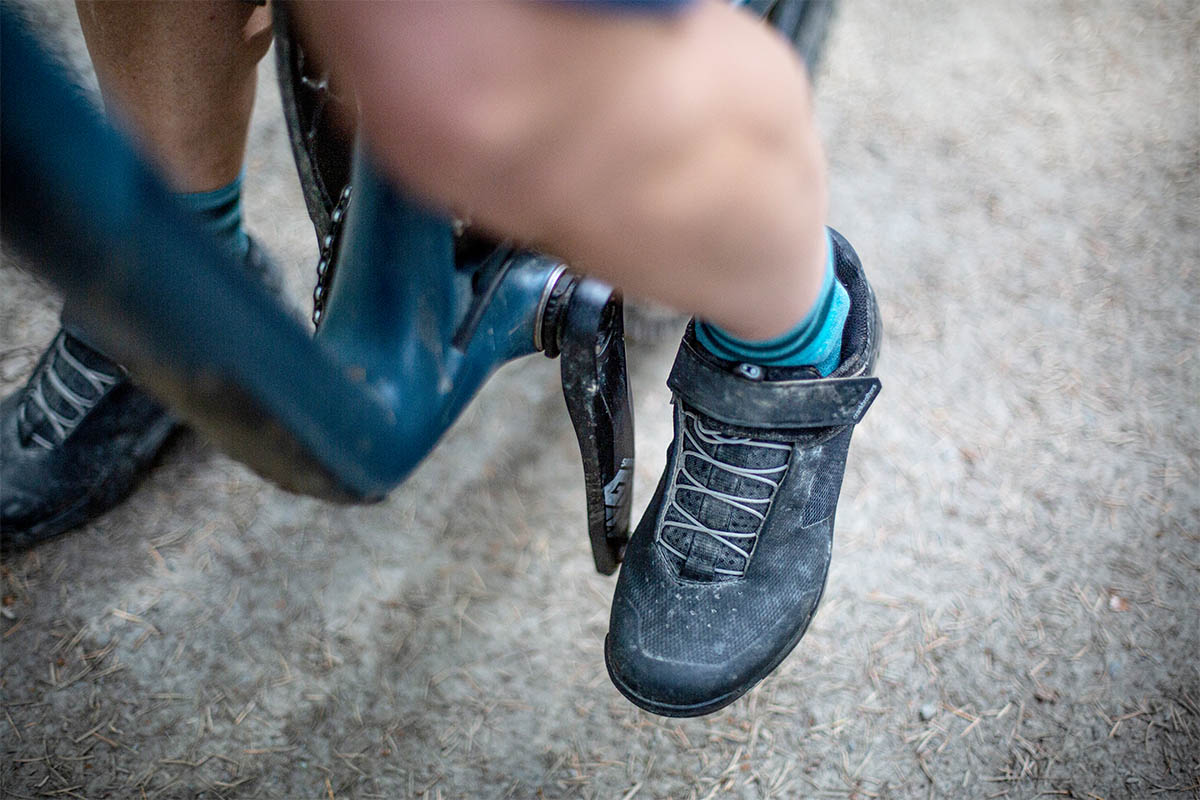
A lightweight mountain bike shoe comes with numerous benefits. Cutting away weight reduces the amount of effort required to put the power down, which also helps with fatigue on long rides. That being said, weight doesn’t get nearly as much attention in the mountain biking market as it does in the running or hiking worlds. Part of the reason is that many bikers stick to shorter rides, but the main factor is that most shoes only vary by a few ounces for the pair. Taking a look at the comparison chart above, the average men’s model comes in at approximately 1 pound 11 ounces. Outliers include the crazy-light Specialized S-Works Recon (1 pound 3 ounces), which is streamlined to maximize efficiency for cross-country racing. On the other end of the spectrum is the downhill-oriented Five Ten Hellcat Pro (2 pounds 6 ounces), which adds heft with its heavy cushioning and protection. But the majority of XC, trail, and even many downhill designs are close enough that weight isn’t a top consideration.
Mountain biking is a rough sport, and moving quickly over technical trails demands a lot from your footwear. Nearly all shoes include a toe cap to take the sting out of a rock strike, but there are notable differences between shoe categories (XC, trail, and downhill). Cross-country riding prioritizes weight and power transfer over all-out protection, so they’re usually the thinnest along the sides and top of the foot. Trail shoes have more cushioning for taking falls, and downhill/freeride designs are the burliest.
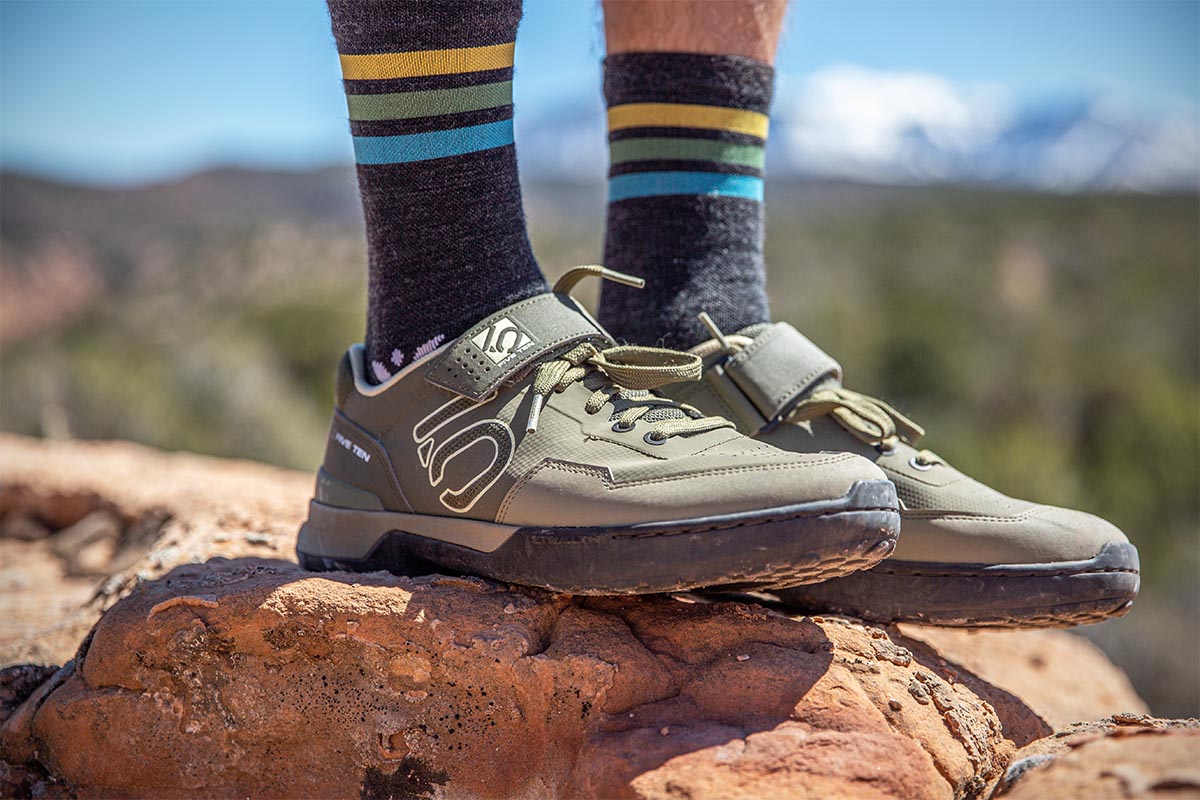
An additional consideration is protection underfoot. Shoes with thin mid and outsoles may not provide enough in the way shock absorption, which can become painful over lengthy sections of rocky and rooty trail. Again, trail and downhill shoes provide the highest levels of comfort in these cases. A design like the Five Ten Hellcat Pro does an impressive job keeping your feet isolated and safe.
.jpg)
Depending on where you ride, wet and muddy trails can be a fact of life. The good news is that most XC, trail, and downhill shoes do a decent job at resisting moisture with solid synthetic or leather uppers and a DWR coating. The strongest performers, such as the Giro Terraduro Mid and Five Ten Impact High, even have a taller ankle height or extended cuff for extra protection. And shoes that are easy to clean are a nice bonus—look for minimal seams, sleek fabric, and covered laces such as those on Shimano’s SH-ME7.
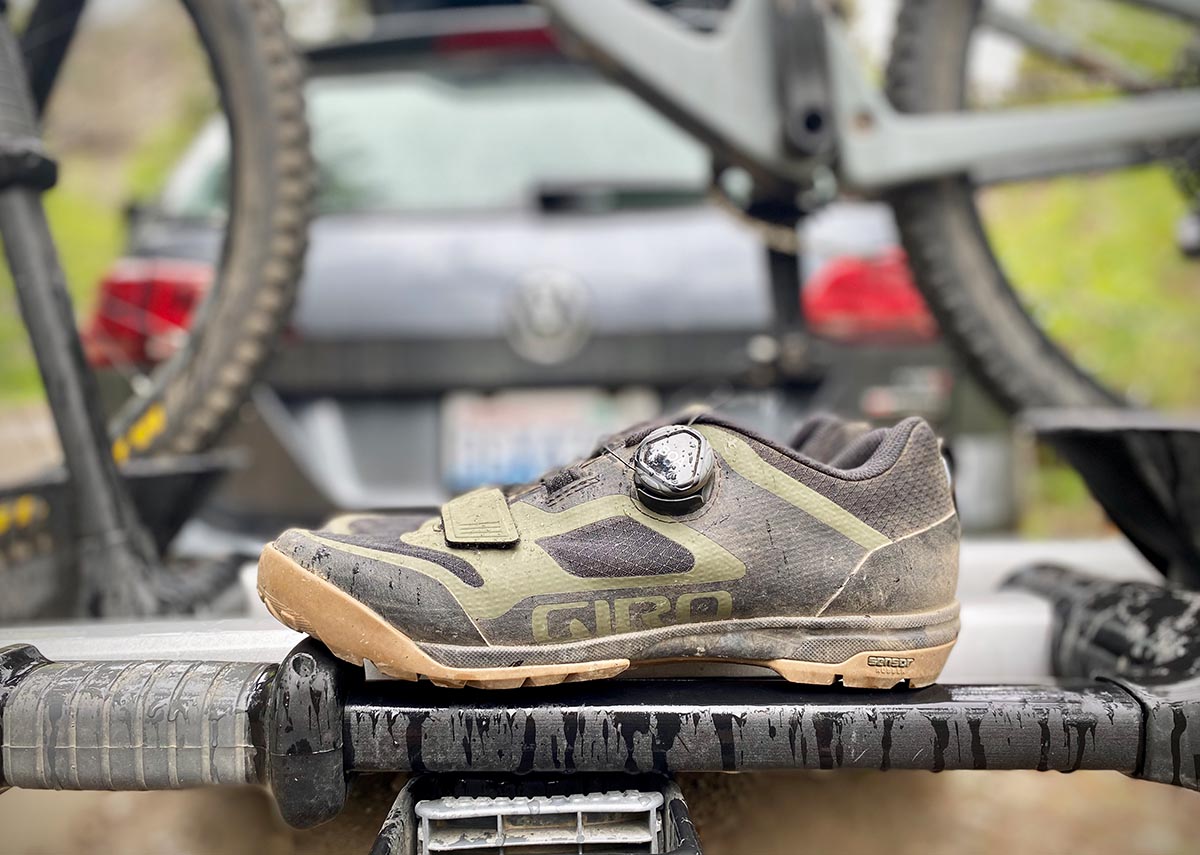
What about fully waterproof shoes? There are a few options out there, including the flat-pedal Five Ten Trailcross GTX and clipless-compatible Shimano’s SH-MW702. For some, a fully waterproof shoe can be valuable for surviving the winter season, especially in areas that see temperatures dip below freezing. For others, however, it’s overkill. They are heavy, lack the breathability to be practical in anything but truly cold temperatures, and don’t dry out nearly as quickly as non-waterproof options. Plus, they’ll cost you a fair bit more than a standard shoe and you’ll give up a lot in terms of versatility. An alternative for occasional winter riders is to wear a neoprene cover or bootie overtop of your standard shoes for a boost in warmth and water resistance (but keep in mind, these are vulnerable to tearing when subjected to trail abuse).
If you do a lot of pedaling on your rides or live in a warmer climate, it’s worth getting a shoe that emphasizes breathability. Telltale signs of a good ventilating design are large swaths of mesh or a thin upper material. On the other hand, shoes with a solid upper and thick cushioning—often found in the downhill category—are the most prone to running hot. You do compromise durability and weather resistance with a highly breathable shoe—mesh tears much more easily and doesn’t resist moisture. But a well-thought-out build like the Shimano SH-ME5 balances those conflicting needs. With perforations throughout the upper material, it’s impressively cool in the heat. At the same time, a water-resistant synthetic upper holds up well to abrasions and poor weather.
.jpg)
Mountain bike footwear doesn’t wear down as quickly as a pair of trail runners, but they’re still not well known for their long-term durability (especially flat pedal models). It’s not uncommon for riders that get out a lot to go through a pair every season or two. Common wear points are the upper material breaking down or getting holes, or the sole delaminating (older versions of Five Ten’s Freerider and the original Giro Terraduro had issues with the latter). Additional problems include the tread of a super sticky flat pedal shoe compound wearing down from extended hiking. As mentioned above, most manufacturers don’t have sparkling durability records. However, Sidi is one brand that has a solid reputation for building products that last, but they’re also among the most expensive on the market.
We touched on this in the stiffness and outsole sections above, but walkability is a very important feature for some riders. Ambitious backcountry trips or bikepacking adventures can often involve lengthy climbs, which means you need your bike shoes to play two roles—one as a capable and efficient biker, and the other as a grippy and decently comfortable hiker. The best hiking shoe often is not that great for biking—moderate flexibility is good for walking but bad for power transfer—so we look for hybrid designs that are adept at both. The Five Ten Freerider is a very comfortable shoe off the bike (although its dotty tread doesn’t grip well in mud), and leading clipless designs include Shimano's SH-ME5 and SH-ME7 and Pearl Izumi's X-Alp Summit.
.jpg)
Feet and toes are ruthlessly exposed to the elements while riding and very liable to numb out in the colder months, but this is where a winter-specific shoe can be a big help. Look for shoes with a waterproof liner to keep your feet dry and warm (and maybe some insulation depending on need), a sealed cleat bed to keep water out while splashing through puddles (for clipless models), and a glove-friendly or simple closure system. Five Ten's Trailcross GTX, with a high neoprene cuff and Gore-Tex liner, does a great job of incorporating all these features into a streamlined and relatively lightweight package. While such a shoe is not recommended for year-round use, it can be a solid investment for dedicated cyclists. And take note: if your winter months are especially brutal, it can be a good idea to size up a half to full size to make room for thick socks.
The vast majority of mountain bike shoes come in a low-top style. Sitting under the ankle, they’re usually comfortable, lightweight, and a quality pair becomes nearly invisible while pedaling. But for bad weather conditions or if you prioritize maximum protection, there are a few mid-height designs. Shoes like the Five Ten Impact Pro Mid protect the inside and outside of the ankle from friendly fire from the crank arm or when falling. But there is a reason most XC, trail, and even downhill riders stick to a low-top shoe. The taller build runs warmer in the heat, can feel cumbersome while pedaling, and is quite a bit heavier. Serious riders that get out all year round might want a mid-height shoe in their quiver, but most should stick to the standard low top.
The simple truth is that for casual riding with flat pedals, you don’t necessarily need to purchase biking-specific shoes. Many people start out with a pair of cross trainers, skate shoes, or running footwear, and those will do the trick for a while. But as you progress, the benefits of one of the options above become clear. Mountain bike shoes offer far better power transfer, foot protection (an essential feature in rocky terrain), and—most importantly for flat pedal use—grip. And if you’ll be jumping on a bike with clipless pedals, then you’ll need a compatible shoe right off the bat.
Back to Our Top Mountain Bike Shoe Picks Back to Our Shoe Comparison Table